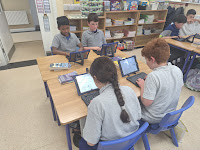This year, our class is diving into the exciting world of typing! As we become more tech-savvy, learning to type efficiently is an important skill that will help us in school and beyond.
What is the Home Row?
One of the first things we’ll learn is the "home row." This is where our fingers will rest when we’re not typing. The home row keys are:
Left Hand: A, S, D, FRight Hand: J, K, L, ; (semicolon)
To help us remember, we can feel the little bumps on the F and J keys. These bumps are like our guiding stars, helping our fingers find their way back home!
Correct Fingering Position
Here’s how to position our fingers:
Left Hand: Pinky on A, Ring on S, Middle on D, Index on FRight Hand: Pinky on ;, Ring on L, Middle on K, Index on J
Our thumbs will be ready to hit the space bar whenever we need it!
Why Is Typing Important?
Typing is a skill we’ll use throughout our lives. It helps us communicate better, complete schoolwork faster, and even explore new ideas online. Plus, being a good typist can make writing projects more fun!
Practice Makes Perfect
To become great typists, we’ll practice regularly. We’ll start with simple words and sentences, focusing on accuracy before speed. We can’t wait to see how much we’ll improve!








Comments
Post a Comment